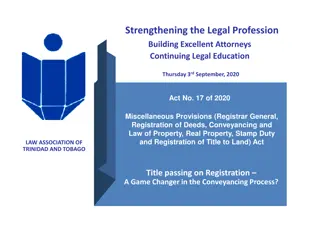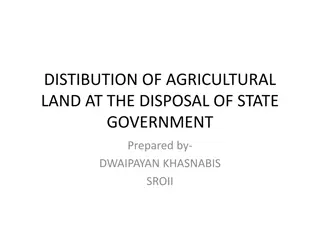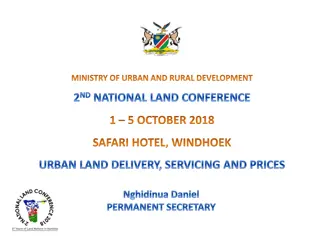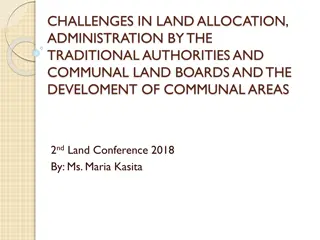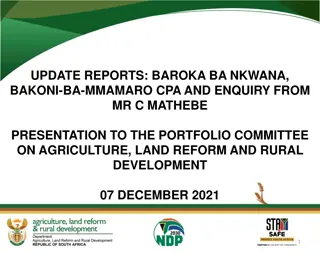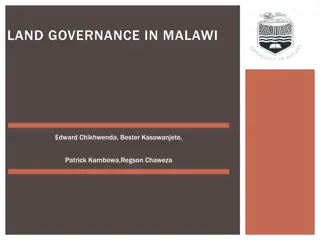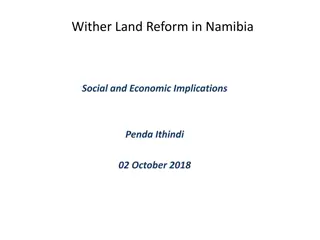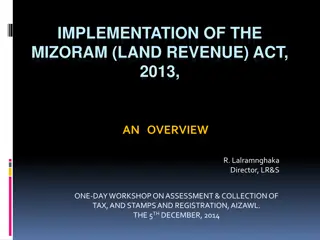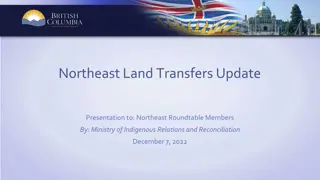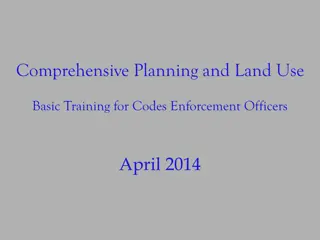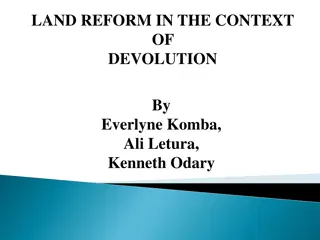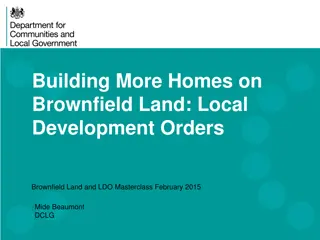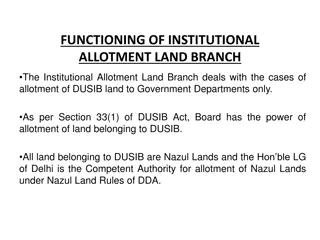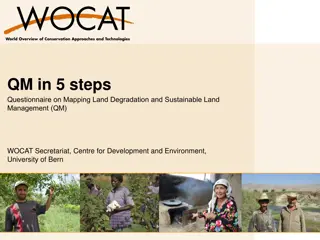Government Agenda for Brownfield Land Development
Unpacking the government agenda for brownfield land development involves key elements such as the Brownfield Register, Permissions in Principle, Local Plan Changes, and the push to convert office spaces to residential units. The government is committed to utilizing brownfield land efficiently, setting targets for local councils, and ensuring that 90% of suitable brownfield sites have planning permissions for housing by 2020. The aim is to eliminate obstacles and streamline the redevelopment process to encourage more construction on brownfield sites.
Download Presentation

Please find below an Image/Link to download the presentation.
The content on the website is provided AS IS for your information and personal use only. It may not be sold, licensed, or shared on other websites without obtaining consent from the author. Download presentation by click this link. If you encounter any issues during the download, it is possible that the publisher has removed the file from their server.
E N D
Presentation Transcript
The Government Agenda Unpicking the parts: - (PAS & you) Permissions in Principle , Brownfield Register and Allocated Sites Starter Homes Local Plan Changes Office to Residential Planning Performance
The Government Agenda: unpicking the parts 1. Brownfield land: the Register and the permission in principle Phillipa Silcock www.pas.gov.uk November 2015
NPPF brownfield land Planning policies and decisions should encourage the effective use of land by re- using brownfield land provided that it is not of high environmental value Local councils can set locally appropriate targets for using brownfield land
Consultations and Incentives Consultation Jan 2015 Introduced the Brownfield register LPAs required to ensure that 90% of sites of the register have planning permissions in place by 2020 Envisaged planning permissions or local development orders Penalties for LPAs who did not succeed
Government commitments Manifesto Commitments ensure that brownfield land is used as much as possible for new development require local authorities to have a register of what is available, and ensure that 90 per cent of suitable brownfield sites have planning permission for housing by 2020
Fixing the foundations. July 2015 The government is clear on the need to promote use of brownfield land, and will remove all unnecessary obstacles to its re-development
Those obstacles. Where development proposals require individual planning permission and are subject to detailed and discretionary scrutiny slow, expensive and uncertain process reduces the appetite to build.
Housing and Planning Bill Permissions in principle (clause 102) 2 kinds: By application decided by councils Granted by the SoS through a development order Councils to keep various registers (clause 103) brownfield land suitable for housing
Permissions in principle Issues How to ensure upfront certainty on in principle issues before getting into detailed, technical considerations? Policy Aims Up front, binding certainty on fundamental issues for all users reducing upfront costs/resource Improve the efficiency of the planning system by minimising repeated effort by both developers and local planning authorities
Permissions in Principle Permission in principle model Technical Details Consent (TDC) Permission in Principle (PIP) Permission to Build Permission in Principle (PIP) certainty on in principle issues of land use, the location and the amount of development Technical Details Consent (TDC) Sufficient process to deal with technical matters
Permissions in Principle Type 1: granted by development order S59(A) Type 2: granted by councils S59(A) (i) Plan and Registers grant permission in principle Application for permission in principle (Small sites) Neighbourhood Plan Brownfield register Local Plan Application for Technical Detail Consent (S70)
Permission in principle from the Explanatory Notes Type 1 PiP by Order Initially only land allocated in brownfield register, DPDs and NPs will be capable of obtaining PiP The Order will set out type and scope of development to be granted PiP Current intention is that this will be limited to sites for housing Will indicate site, location and amount of development PiP will only be granted when the register, DPD or NP is adopted or made by the council The Order will specify how long the PiP will last and what transitional arrangement will follow when the PiP expires
Permission in principle from the Explanatory Notes Type 2 PiP the application The DMPO will specify the steps for the council to take following an application Councils cannot grant PiP subject to conditions Applications likely to be for less than 10 units Councils will hold a register of all PiPs ( both kinds) It will also set out steps for a technical detail consent application
Permissions in principle Technical details consent Fee consistent with applications fees for similar development Can t reopen the principle of development through a TDC application Conditions can be imposed at this stage PiP may not bind where there has been a change of circumstances .
Brownfield Register Issue: How to incentivise the development of previously developed land, given that this land may have higher development costs Policy Aims: improve the availability and transparency of information, providing certainty and encouraging investment help to measure progress in delivering permissions Build on existing plan making processes to avoid additional work
Brownfield Register Housing and Planning Bill (Clause 103) Councils will be required to compile a register of previously developed land in their area which is suitable for housing The criteria for which land should be placed on the register will come in secondary legislation
Brownfield Register Reasonable to assume that the site assessment/criteria to determine suitability for housing will be Based on SHLAA process, including annual reviews of potentially suitable sites Taking existing policy and guidance as its starting point - Does the site comply with the NPPF definition of previously developed land? From the January consultation Is the site: Deliverable; Free of Constraint (that cannot be mitigated); Capable of Development; Capable of supporting 5 or more dwellings (on sites 0.25ha and above*). Reminder in the Bill that in determining which land should go on the register the LPA will have to have regard to the development plan, national policies, advice and guidance
Brownfield Register from the explanatory notes Register likely to be in several parts: Land suitable for housing that meets specified criteria Land in the part 1 register that the LPA considers is suitable for the grant of PiP and which has been through a consultation process (but not incl. land with planning permission) Land which does not meet the criteria, but which the LPA wishes to include e.g. suitable for 4 of fewer houses
Brownfield Register Possible exclusions: Indications of some discretion about including land where the development would be particularly controversial and the LPA considers that the decisions should be made through a planning application. Will this also include sites that would require EIA/ HRA appraisals?
Brownfield Register What information to look out for on the register? Site reference Address Size Estimate of the number of dwellings, Planning status DCLG consultation on implementation details coming soon
The package Questions: Has the 90% requirement been dropped? Will the existing SHLAA process give LPAs enough confidence in the principle of development? Deliverability more viability testing - who pays? More up front work for Councils ( and neighbourhood groups) at a time of tough resource constraints? Consultation with communities and statutory consultees? Appeals by both landowners and by neighbours Will it impact on plan preparation? Transition arrangements for plans/ allocations already in place?
The package Big Questions for the development community: Will the brownfield register provide information of site availability that at present you don t have access to? Will the permission in principle reduce uncertainty in the planning process enough to give you better access to funding?
Table Questions 40mins Q1. How do you think PiPs will affect your places? What do you think Planning in Principles will do for delivery in your area? Q2. How will having a Planning in Principle on allocated or brownfield sites affect your local plan? Q3. How will it affect decision making on individual sites/applications? Q4. What impact will this have on finances and resources? Q5. A) Are you doing anything already? B) Are there any further questions that you have following your discussions?
The Government Agenda: unpicking the parts 2. Starter Homes Steve Barker www.pas.gov.uk November 2015
STARTER HOMES For sale at a maximum of 8O% of market rates 20% saving coming from removal of S106 and CIL provisions Limited to first time buyers under 40 Price reduction will last for 5 years Price to be capped at 450k in London and 250k elsewhere Be available on all reasonable sized sites
STARTER HOMES LPAs to have a duty to "carry out its relevant planning functions with a view to promoting the supply of starter homes" LPAs will be able to negotiate the tenure of houses with a developer But Starter Homes would be a priority 200,000 target by 2020
Table Questions 25 mins Q1. How do you think Starter homes will affect your places? What do you think Starter Homes will do for delivery in your area? Q2. Do you have an idea of need for Starter Homes in your area? Q3. What impact will this have on finances and resources? Q4. A) Are you doing anything already? B) Are there any further questions that you have following your discussions?
The Government Agenda: unpicking the parts 3. Local Plan Intervention & The Local Plan Review Process Steve Barker www.pas.gov.uk November 2015
LOCAL PLAN INTERVENTION The Government are very, very keen to see total plan coverage by end of Parliament 60 (ish) LPAs without post 2004 strategic plans H&P Bill introduces powers for SoS to intervene to bring LPA plans forward A deadline of early 2017 for plans to be produced
LOCAL PLAN INTERVENTION The Government: it will intervene to arrange for the plan to be written, in consultation with local people, to accelerate production" Brandon Lewis to the select committee - DCLG would "not necessarily" write plans itself in cases where no local plans have been produced by early 2017
LOCAL PLAN INTERVENTION We don t know: how an intervention will work? who would do it? LPA with help, PINs, PAS, ??? what early 2017 means? what a produced plan is? adopted? submitted? published? ???
LOCAL PLAN INTERVENTION There is potential to extend this intervention to pre NPPF plans!!
LOCAL PLAN PROCESS REVIEW The Government set up a panel in Sept 2015 to advise them on streamlining the local plan process Request for Evidence closed - end Oct 2015 Due to report findings - end of Feb 2016
LOCAL PLAN PROCESS REVIEW The review focus on how plans are: prepared by LPAs examined adopted with an aim of speeding up the process. It aims to identify barriers to local plan-making and make proposals on how to improve the process.
LOCAL PLAN PROCESS REVIEW Some of the specific areas it is examining are: are plans are taking on too many issues how the process is resourced better collaboration between authorities to produce plans together, how strategic housing need is addressed, the duty to cooperate process, evidence requirements for a plan, and tackling political differences stopping plans emerging.
Table Questions 20 mins Q1. a) Will this affect you presently? Will it alter your present timetable for production? Q1 b) if the designation moved to affect pre NPPF plans (pre 2012) before 2020 would this affect you? Would it alter you timetable for updating? Q2. Will this affect how you are resourcing your planning policy? Q3. Have you got any ideas of shortening/improving the planning making process? Q4. A) Are you doing anything already? B) Are there any further questions that you following your discussions?
The Government Agenda: unpicking the parts 4. Office to Residential Permitted Development Steve Barker www.pas.gov.uk November 2015
OFFICE TO RESIDENTIAL PERMITTED DEVELOPMENT Introduced 2013 as temp PD right Was due to finish in may 2016 Popular with developers (what a surprise!) Government likes it as opportunity to delivering housing and not touch Green Belt Announced it will be made permanent and expanded to include demolition of office buildings for new resi B1(c) (light industrial)
OFFICE TO RESIDENTIAL PERMITTED DEVELOPMENT Extension of PD right will be subject to prior approval by LPA Expected B1(c) conversions subject to impact on neighbouring employment uses not being unacceptable what this means I don t know but it will be probably be decided by the Courts!
OFFICE TO RESIDENTIAL PERMITTED DEVELOPMENT Previously secured prior approvals under present right will have extra 3 years to complete the change of use extending date to May 2019 (from May 2016) The present 17 exemption areas will remain until May 2019 then need to have an Article 4 direction to remove PD right
OFFICE TO RESIDENTIAL PERMITTED DEVELOPMENT Housing and Planning Minister Brandon Lewis (13 October 2015) We re determined that, both in Whitehall and in town halls, everything is done to get the homes we need built. Today s measures will mean we can tap into the potential of underused buildings to offer new homes for first-time buyers and families long into the future, breathing new life into neighbourhoods and at the same time protecting our precious green belt.
Table Questions 20 mins Q1. Has it already and how do you think the underused office to residential permitted development will affect your places? Do you have office units that you could reasonably expect this to affect? Q2. How will an inclusion on Light Industrial (B1c) affect your area? Q3. How would demolition of office units to residential affect your area? Q4. Will the removal of current exemption sites (May 2019) to be replaced by an Article 4 direction affect your area? Q5. How will it affect delivery of your housing and economic strategies? Q6. A) Are you doing anything already? B) Are there any further questions?
The Government Agenda: unpicking the parts 5. Planning Application Performance & Reporting Financial Benefits Steve Barker www.pas.gov.uk November 2015
PLANNING APPLICATION PERFORMANCE Major apps performance target 50% in 13 weeks (excl. EoT, PPAs & EIAs) over a rolling two year period. This target has increased over time LPAs inside the target are designated If designated applicants have option to go to PINs for decision rather than LPA
PLANNING APPLICATION PERFORMANCE Regime is being expanded to include non- majors (minor & others) First period of performance expected to be July 2014 to June 2016 - continuing on rolling two year period Not known what target will be? PAS guessing at 60% - only a guess! worth noting that performance period is already in 6th of the 8 quarters!!!
REPORT FINANCIAL BENEFITS H&P Bill includes requirement for reports to planning committees to outline financial benefits likely to accrue to a local authority if a proposed development is carried out.
Table Questions 20 mins Q1. What s your present performance for majors and non- majors? Has the 50% target for majors affected you? Would a 60% target for non-majors affect you (with a projections up to June 16)? Q2. Are you expecting a reduction in planning resources for DM? Will this affect your performance? Would a reduction get you near to designation? Q3. Do you have any concerns about the requirement to set out the financial benefits that a development would bring in reports? Q5. A) Are you doing anything already? B) Are there any further questions that you following your discussions?
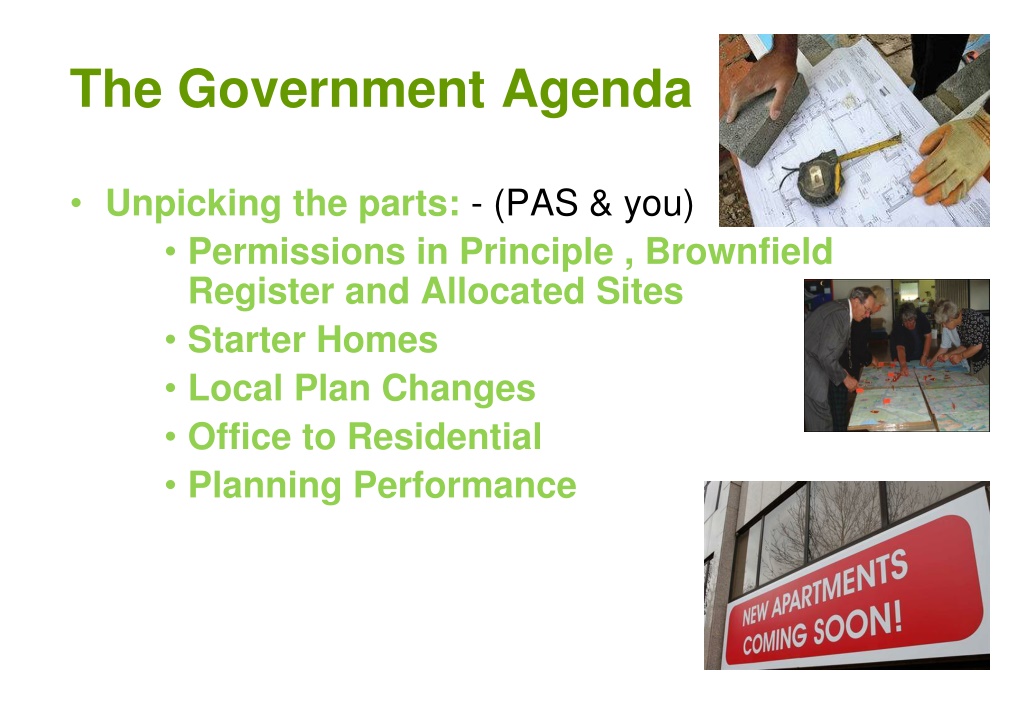




 undefined
undefined




